Kashmiri chili powder has a vibrant red color and mild smoky flavor, making it a popular ingredient in many Northern Indian curries and stews. However, it is not as common in Western kitchens and not as readily available at local grocery stores. If you find yourself in the mood for tandoori chicken and don’t have time to make it to an Indian grocery store, we have 8 great alternatives for Kashmiri chili powder.

Table of Contents
What is Kashmiri Chili Powder?
Kashmiri chili powder is a spice that comes from dried Kashmiri peppers, which are harvested in the Kashmir region of Northern India. The chiles and the powder are known for having a bright red color, and sweet smoky taste. It is also a relatively mild chili powder, especially in Indian cuisine, with a Scoville heat unit (SHU) range of 1,000 to 2,000. For comparison, this is less spicy than a mild jalapeño that has a SHU range of 2,500 to 8,000.
How is Kashmiri Chili Powder Commonly Used?
Kashmiri chili powder is commonly used in Northern Indian cuisine. It’s mild flavor allows you to add a smoky flavor and a little heat to a dish without overpowering it. It’s vibrant red color allows you to add color to dishes such as Tandoori and butter chicken without using food coloring. Kashmiri chili powder appears in many Indian dishes, including various sauces, marinades, spice blends, and curries.
Substitutes for Kashmiri Chili Powder
1. Smoky Paprika/Cayenne Pepper Blend

In my opinon, the best way to match the flavor of Kashmiri chili powder is by combining smoky paprika and cayenne pepper. If you don’t have smoky paprika, regular will do but you won’t get the smoky flavor Kashmiri chili is known for.
Smoky paprika is very mild while cayenne pepper can have a kick similar to Indian red chili powder. Combining the two creates the perfect balance of flavor and heat found in Kashmiri chili powder.
I like to use about three parts paprika to one part cayenne pepper to avoid making the dish too spicy. You can use the blend as a 1:1 substitute.
2. Indian Red Chili Powder
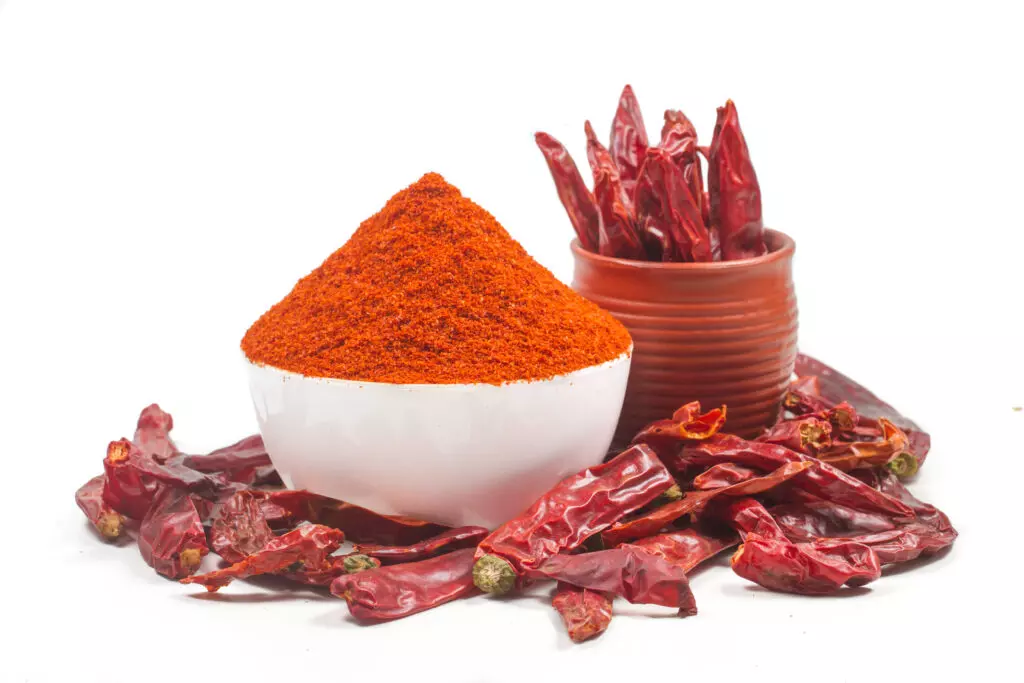
Indian red chili powder consists of a variety of red chiles that have been dried in the sun and ground to a fine powder. It has a color and consistency similar to Kashmiri chili powder, but it’s much spicier.
Depending on the types of chiles used and from what region they were harvested, the heat and flavor of Indian red chili powder can vary. However, it is safe to say that it is considerably spicier than Kashmiri chili powder with a SHU range of 40,000 to 60,000.
I would use about a quarter-teaspoon of red chili powder for each teaspoon of Kashmiri chili powder called for in your recipe. When substituting ingredients with more heat than than the one you are replacing it is important to start with a little bit, taste, and add more if necessary. I’ve made the mistake too often of being too aggressive with my peppers and ended up creating a dish much spicier than I intended.
3. Ground Guajillo Chiles
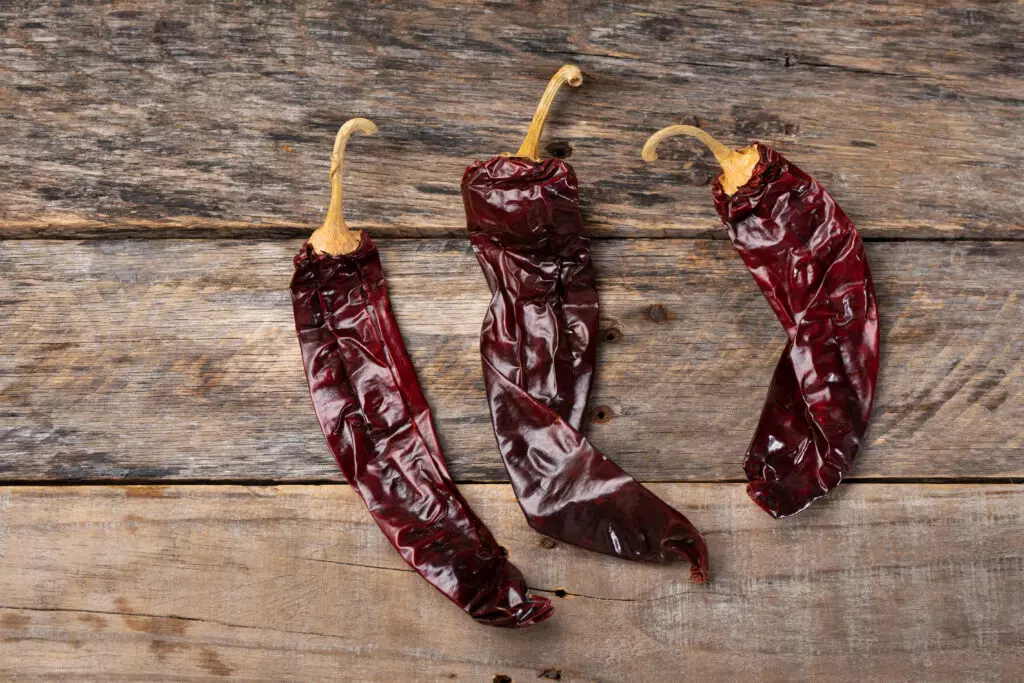
Guajillo chiles are dried mirasol chili peppers with a deep red color. They have a mild to medium heat with a SHU range of 2,500 to 5,000. That puts them as between Kashmiri chiles and Indian red chili powder on the Scoville scale.
Like Kashmiri chiles, guajillos have a slightly smoky flavor which makes it a good substitute. However, it does not have the vibrant red color. If this is an important factor in the presentation of your dish, you may want to consider other alternatives.
Before using, I would grind the guajillo chilies into a powder and start with a 1:2 substitute, adding more to taste.
4. Ancho Chili Powder

Ancho chili powder is made from poblano peppers that have been ripened to maturity (giving them a brownish-red color instead of the green commonly associated with poblanos), dried in the sun, and ground into flakes. It’s frequently used as a substitute for other chili powders and paprika.
Not only does ancho chili powder have similar heat to Kashmiri chili powder with a SHU range of 1,000 to 1,500, it also has a sweet and smoky taste.
However, like guajillo chiles, ancho chili powder does not have the bright red color commonly associated with Kasmiri chiles. If this is an important consideration, another option may be better. If you are just looking to just match flavors, this is a great option and can be substituted on a 1:1 ratio.
5. Chipotle Chili Powder
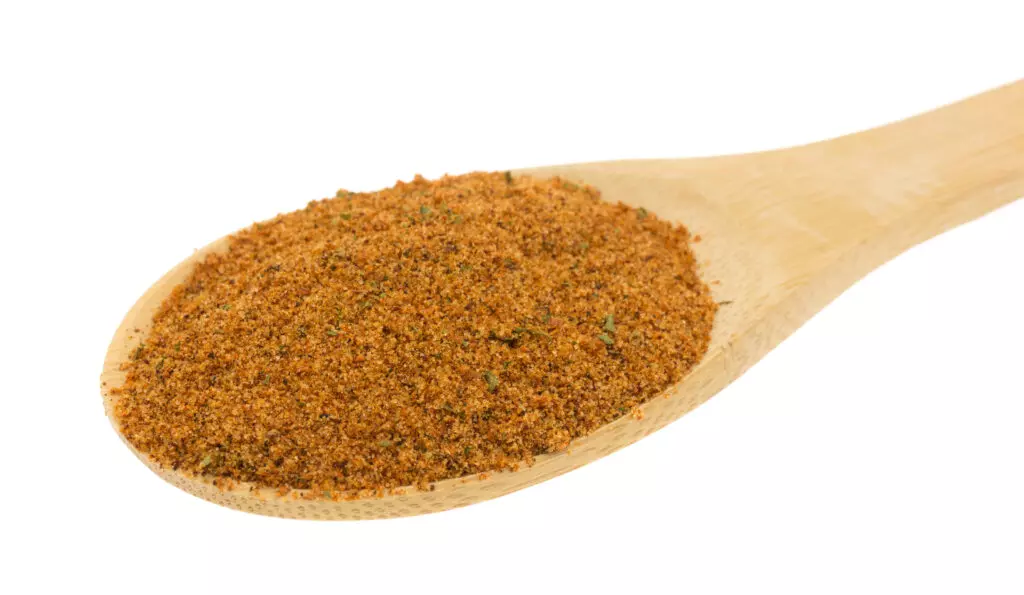
Chipotle chilies are jalapeño peppers that have been ripened to maturity, giving them a red color, dried, and smoked. The peppers are then ground to make chipotle powder. Like jalapeños, it has a SHU range of 2,500 to 8,000, making it a spicier than Kashmiri chili powder.
While it’s commonly used in Mexican cuisine and has flavors distinct to that region, it can be a good substitute as it also has a sweet and smoky taste similar to Kashmiri chili powder. Like some of the other options, chipotle powder does not have the same red color that Kashmiri chili powder is known for. If this is important, it is definitely something to consider.
It’s relatively hot compared to Kashmiri chili powder, so you may want to start with less, such as half a teaspoon for each teaspoon of Kashmiri powder, and add more to taste.
6. New Mexico Chili Powder
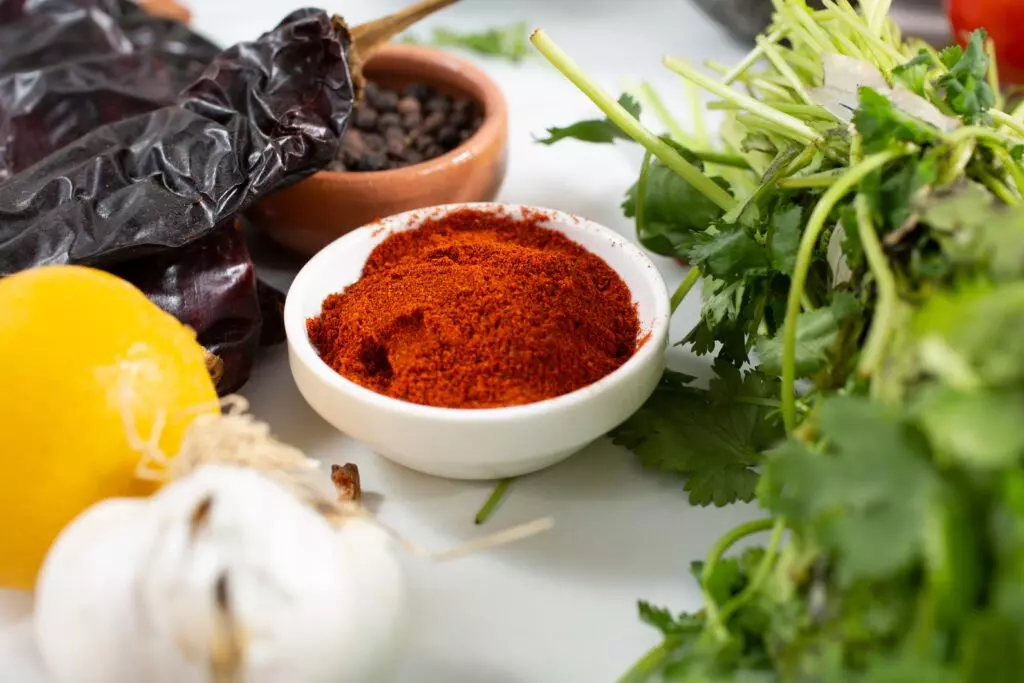
New Mexico chili powder is an orange chili powder often used in soups and stews in Southwestern recipes. It’s made from New Mexico chiles that have been fully ripened, dried, and ground into a powder.
It is comparable to Kashmiri chili powder when it comes to flavor and heat profiles with a SHU range of 800 to 1,400. Given the similarities in heat, you can substitute this on a 1:1 ratio without overpowering your dish.
7. Gochugaru
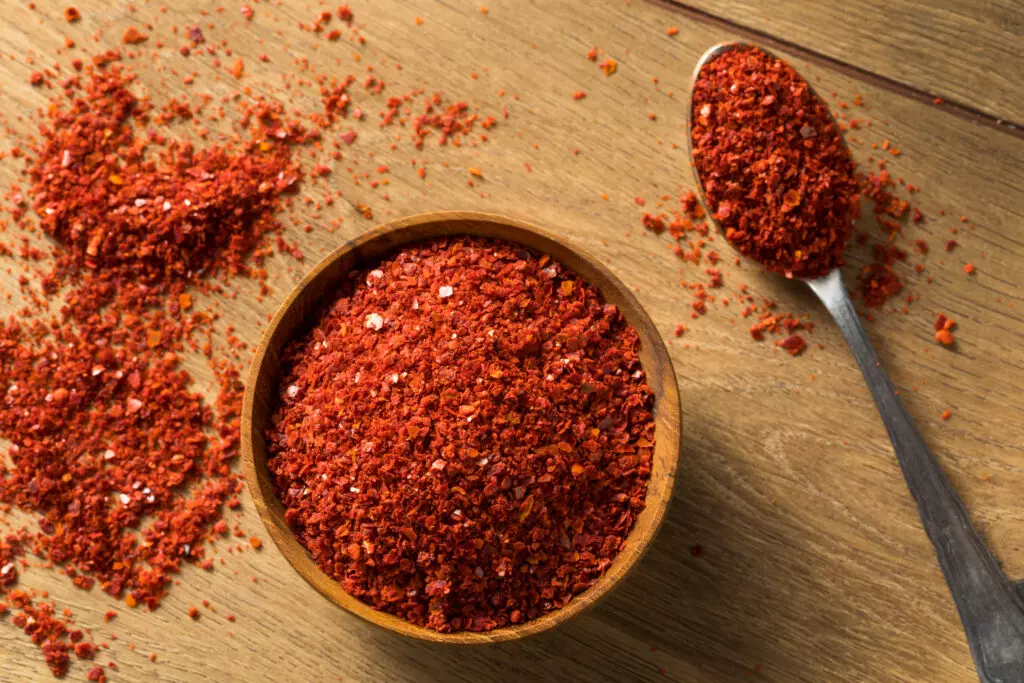
Gochugaru is a Korean chili powder found in kimchi and other Korean dishes. It features a blend of sweet, smoky, and fruity flavors that work well as a substitute for Kashmiri chili powder.
It has a SHU range of 1,500 to 10,000, depending on the variety. When using it as a substitute for Kashmiri chili powder, look for the mild versions, which are often closer to 1,500 SHU.
Given the range of spice levels, it is important to taste prior to using as a substitute to make sure you are comfortable with the flavor and heat. I would then start with small amounts and add more as needed, tasting frequently as you add.
8. Chili Powder
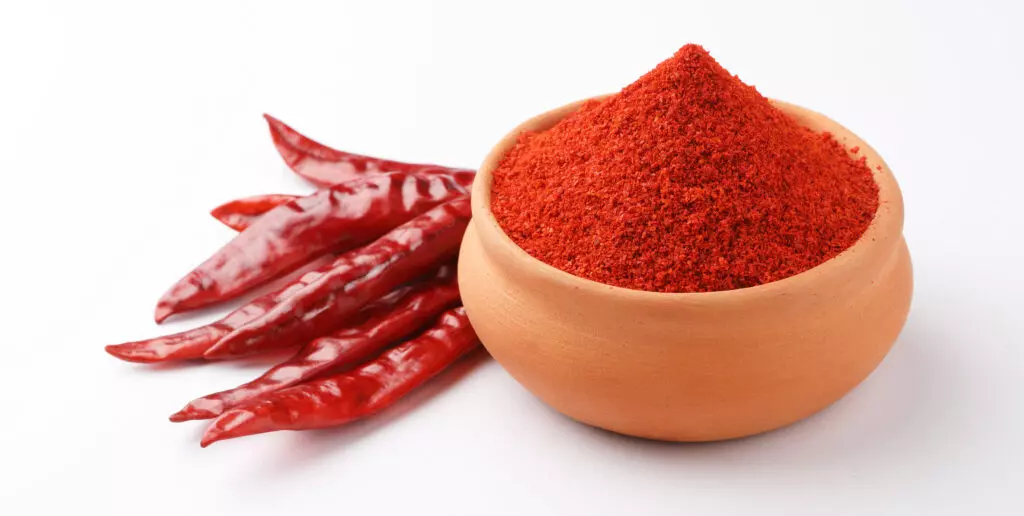
One of the simplest substitutes for Kashmiri chili powder is standard chili powder. This is a great substitute because it is common in most Western kitchens and likely will not require a special trip to the store.
Most varieties include a mixture of ground red chiles, that are sometimes smoked prior to being ground. Chili powder has comparable heat to Kashmiri chili powder with a SHU range of 500 to 1,500. Given this, you can use as a direct substitute.
One thing to take into consideration when using chili powder is that it does sometimes vary in flavor depending on what peppers are used and whether they are smoked prior to using. I always urge you to taste before using so you understand and are comfortable with the heat and flavor.
Frequently Asked Questions
What Does Kashmiri Chili Powder Taste Like?
Kashmiri chili powder has a mild taste. It’s slightly sweet and smoky with a noticeably fruity aroma, but it’s much milder compared to the other chili powders often used in Indian cuisines, such as ghost pepper or Indian red chili powder.
Is Kashmiri Chili Powder Good for You?
Kashmiri chili powder is a great source of antioxidants, vitamin C, and vitamin B. Vitamin C is essential to the health of your skin and hair while vitamin B helps maintain the health of your nervous system.
Final Thoughts on Substitutes for Kashmiri Chili Powder
I love Indian food, however, the ingredient list can be a little intimidating for the home cook if you are not used to Indian cooking. I would encourage anyone to go seek out your nearest Indian grocery store and begin the journey of building your spice collection one recipe at a time. However, if you don’t have one nearby or don’t have the time to venture out, I hope the substitutes above will help you on your journey of discovery into the world of Indian cuisine.
Check out the below articles for more great substitute articles:
Top 10 Substitutes for Jalapeño Peppers
Top 8 Substitutes for Guajillo Chiles
Top 10 Substitutes for Anaheim Peppers
Also, subscribe to our YouTube Channel for some great videos!
